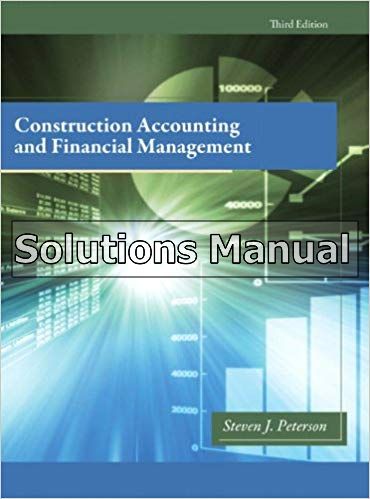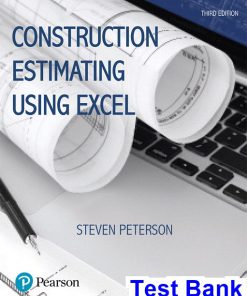Construction Accounting and Financial Management 3rd Edition Peterson Solutions Manual
$26.50$50.00 (-47%)
Construction Accounting and Financial Management 3rd Edition Peterson Solutions Manual.
You may also like
Construction Accounting and Financial Management 3rd Edition Peterson Solutions Manual
 Product details:
Product details:
- ISBN-10 : 0132675056
- ISBN-13 : 978-0132675055
- Author:
CONSTRUCTION ACCOUNTING & FINANCIAL MANAGEMENT, 3/e helps construction professionals and construction management students master the principles of financial management, and adapt and apply them to the challenge of profitably managing construction companies. It integrates content that has traditionally been taught through separate accounting, finance, and engineering economics texts. Students learn how to account for a construction company’s financial resources; how to manage its costs, profits, and cash flows; how to evaluate different sources of funding a company’s cash needs; and how to quantitatively analyze financial decisions. Readers gain hands-on experience through 220 example problems and over 390 practice problems, many of them based on situations actually encountered by the author. This edition adds more than 100 new discussion questions, and presents financial equations and accounting transactions more visually to support more intuitive learning.
Table contents:
PART I
INTRODUCTION TO
CONSTRUCTION FINANCIAL
MANAGEMENT 1
CHAPTER 1 Construction Financial
Management 2
What Is Financial Management? 3
Why Is Construction Financial Management
Different? 3
Project Oriented 3
Decentralized Production 4
Payment Terms 4
Heavy Use of Subcontractors 4
Who Is Responsible for Construction
Management? 4
What Does a Financial Manager Do? 5
Accounting for Financial Resources 5
Managing Costs and Profits 6
Managing Cash Flows 6
Choosing among Financial Alternatives 7
● Conclusion 7 ● Discussion Questions 7
PART II
ACCOUNTING FOR FINANCIAL
RESOURCES 9
CHAPTER 2 Construction Accounting
Systems 10
Cost Reporting versus Cost Control 10
The General Ledger 11
Method of Accounting 11
Cash 12
Accrual 13
Percentage of Completion 13
Completed Contract 13
The Balance Sheet 14
Assets 15
Liabilities 16
Owners’ Equity 17
The Income Statement 17
Revenues 18
Construction Costs 18
Equipment Costs 19
Overhead 21
Other Income and Expenses 21
Income Tax 21
The Job Cost Ledger 21
The Equipment Ledger 26
● Conclusion 27 ● Discussion Questions 27
CHAPTER 3 Accounting Transactions 28
Invoice Charged to a Job without Retention 29
Invoice Charged to a Job with Retention 29
Paying Invoices 30
Labor Charged to a Job 31
Labor Charged to General Overhead 32
Paying an Employee’s Wages 33
Paying Payroll Taxes 33
Paying for Benefits 34
Vacation Time for Jobsite Employees 34
Recording Office Rent 35
Recording Office Depreciation 36
Recording General Overhead Invoices 36
Billing a Client 37
Billing for Retention 38
Receiving Payment from a Client 38
Purchase of Equipment with a Loan 39
Loan Payment 39
Equipment Depreciation 40
Leased Equipment with an Operating Lease 40
Leased Equipment with a Capital Lease 40
Lease Payments for a Capital Lease 41
Amortization of a Capital Lease 42
Invoice for Equipment Repairs 42
Equipment Charged to a Job 43
Equipment Charged to an Employee 43
Sale of Equipment 44
Purchase of Inventory 45
Charging Inventory to a Job 45
Signing a Construction or Development Loan 46
Drawing Funds from a Construction or
Development Loan 46
Recording Changes in Costs and Profits in Excess
of Billings 47
vi Contents
Degree of Fixed Asset Newness 89
Months in Backlog 90
● Conclusion 90 ● Discussion Questions 90
● Problems 90 ● Case Study 95
PART III
MANAGING COSTS AND
PROFITS 99
CHAPTER 7 Managing Costs 100
The Monitoring and Controlling Process 100
Monitoring and Controlling Construction
Costs 101
Material Purchases 101
Labor 102
Subcontracts 102
Equipment 103
Other 103
Monitoring and Controlling General
Overhead Costs 104
Monitoring Job Profitability 104
Cost-Loaded Schedule 105
Schedule Performance Index 106
Cost Performance Index 106
Target Levels for CPI and SPI 108
Project Closeout Audit 109
Managing Design-Build Costs 110
● Conclusion 111 ● Discussion Questions 111
● Problems 112
CHAPTER 8 Determining Labor Burden 114
Cash Equivalents and Allowances 119
Payroll Taxes 120
Unemployment Insurance 120
Workers’ Compensation Insurance 121
General Liability Insurance 122
Insurance Benefits 122
Retirement 122
Union Payments 123
Other Benefits 123
● Conclusion 124 ● Discussion Questions 124
● Problems 124
CHAPTER 9 Managing General Overhead
Costs 125
General Overhead Defined 125
The General Overhead Budget 125
Items to Include in the General Overhead
Budget 126
Recording Changes in Billings in Excess of Costs
and Profits 48
● Conclusion 49 ● Discussion Questions 49
● Problems 49
CHAPTER 4 More Construction
Accounting 52
Committed Costs and Estimated Cost at
Completion 52
Overbillings and Underbillings 54
Internal Controls 58
Computerized Accounting Systems 59
● Conclusion 60 ● Discussion Questions 60
● Problems 60
CHAPTER 5 Depreciation 63
Straight-Line Method 64
Sum-of-the-Years Method 64
Declining-Balance Method 66
MACRS 69
Placing in Service and Disposing of an Asset 69
IRS Standard Recovery Periods and Depreciation
Methods 70
Cost Segregation 74
Tax Cuts and Jobs Act 75
Section 179 Deduction 75
Depreciation for Non Tax Purposes 76
● Conclusion 77 ● Discussion Questions 77
● Problems 77 ● Suggested Readings 79
CHAPTER 6 Analysis of Financial
Statements 80
Depreciation and Financial Analysis 81
Quick Ratio 81
Current Ratio 81
Current Liabilities to Net Worth Ratio 82
Debt to Equity Ratio 82
Fixed Assets to Net Worth Ratio 83
Current Assets to Total Assets Ratio 83
Collection Period 84
Average Age of Accounts Payable 85
Assets to Revenues Ratio 86
Working Capital Turns 86
Accounts Payable to Revenues Ratio 87
Gross Profit Margin 87
General Overhead Ratio 88
Profit Margin 88
Return on Assets 88
Return on Equity 89
Contents vii
Nondeductible Expenses/Costs 191
Tax Credits 191
Section 199A 191
Alternate Minimum Tax 191
Projecting Taxable Income 191
● Conclusion 192 ● Discussion Questions 192
● Problems 192 ● References 193
CHAPTER 14 Cash Flows for Construction
Companies 194
Incorporating Construction Operations 194
Incorporating General Overhead 201
Income Taxes, Interest, Loan Payments, and Cash
Balance 204
Determining the Minimum Monthly Balance 208
Fine-Tuning, What-If, and Sensitivity Analysis 208
● Conclusion 210 ● Discussion Questions 210
● Problems 210
CHAPTER 15 Time Value of Money 214
Equivalence 214
Single-Payment Compound-Amount Factor 215
Single-Payment Present-Worth Factor 217
Uniform-Series Compound-Amount Factor 218
Uniform-Series Sinking-Fund Factor 220
Uniform-Series Present-Worth Factor 221
Uniform-Series Capital-Recovery Factor 222
Cash Flow Diagrams 223
Complex Cash Flows 223
Find Unknown Periodic Interest Rates 227
Inflation and Constant Dollars 229
Taxes on Interest 230
● Conclusion 230 ● Discussion Questions 230
● Problems 231
CHAPTER 16 Financing a Company’s
Financial Needs 233
Interest 233
Simple Interest 233
Compound Interest 234
Yield or Annual Percentage Yield 234
Fixed versus Variable Interest Rates 236
Loans and Lines of Credits 236
Loans 237
Long-Term Loans 237
Amortization Schedule 241
Closing Costs 243
Short-Term Loans 247
Estimating General Overhead 129
Types of Costs 129
Sample of a General Overhead Budget 131
● Conclusion 139 ● Discussion Questions 139
● Problems 139
CHAPTER 10 Setting Profit Margins for
Bidding 142
The Profit Equation 142
Contribution Margin 143
Projecting Break-Even Volume of Work 143
Projecting Break-Even Contribution Margin Ratio 144
Adjusting the Financial Mix 145
Profit and Overhead Markup 146
● Conclusion 149 ● Discussion Questions 149
● Problems 149
CHAPTER 11 Profit Center Analysis 151
Sources of Profit 151
Allocation of General Overhead 153
Profit Center Analysis 154
Crews as Profit Centers 155
Project Management as Profit Centers 156
Estimators as Profit Centers 156
Types of Jobs as Profit Centers 156
Customers as Profit Centers 158
Equipment as Profit Centers 159
● Conclusion 159 ● Discussion Questions 160
● Problems 160
PART IV
MANAGING CASH FLOWS 163
CHAPTER 12 Cash Flows for Construction
Projects 164
Cash Flow for Projects with Progress
Payments 164
Cash Flow for Projects with a Single Payment 179
● Conclusion 181 ● Discussion Questions 181
● Problems 181
CHAPTER 13 Projecting Income Taxes 185
Corporate versus Personal Income Tax 185
Taxable Income 185
Payment of Income Taxes 186
Income Tax Rates 186
Marginal or Incremental Tax Rate 187
Capital Gains and Losses 187
Tax Consequences of Depreciation 189
viii Contents
Rate of Return 272
Incremental Rate of Return 275
Capital Recovery with Return 276
Payback Period without Interest 277
Payback Period with Interest 279
Project Balance 280
Noneconomic Factors in Decision Making 281
● Conclusion 282 ● Discussion Questions 282
● Problems 283
CHAPTER 18 Income Taxes and Financial
Decisions 286
Losses Carried Forward 286
Different Tax Rates 287
Depreciation 288
Capital Gains 288
Tax Credits 289
After-Tax Cash Flows 289
● Conclusion 298 ● Discussion Questions 298
● Problems 298
Appendix A Computerized Accounting Systems 299
Appendix B Excel Primer 302
Appendix C Trend Analysis 306
Appendix D Derivation of Selected Equations 310
Appendix E Interest Factors 312
Appendix F Glossary 344
Appendix G List of Variables 350
Index 351
Lines of Credits 248
Compensating Balance 249
Commitment Fee 250
Leasing 251
Trade Financing 251
Credit Cards 252
Equity Financing 253
Selecting a Banker 253
Applying for a Loan 253
Loan Documents 254
● Conclusion 254 ● Discussion Questions 254
● Problems 255
PART V
MAKING FINANCIAL
DECISIONS 257
CHAPTER 17 Tools for Making Financial
Decisions 258
Sunk Costs 260
MARR (Minimum Attractive Rate of Return) 260
Adjusting Life Spans 261
Study Period 261
Shortening an Alternative’s Life 261
Lengthening an Alternative’s Life 262
Repurchasing an Alternative 262
Net Present Value or Present Worth 263
Incremental Net Present Value 268
Future Worth 270
Annual Equivalent 271
People also search:
construction accounting and financial management 3rd edition pdf free download
what is financial management in construction
is financial management accounting
g construction company
construction accounting and financial management












